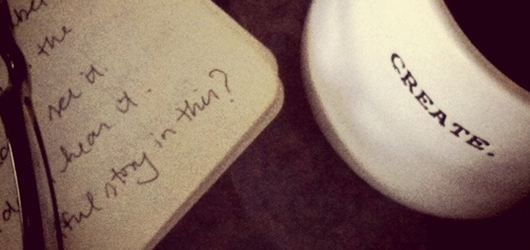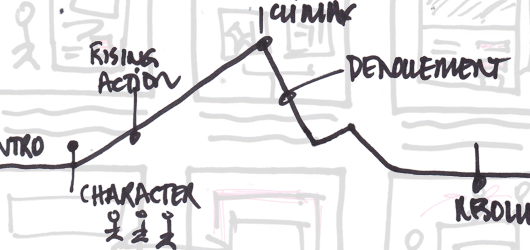I wanted to share a recent article I wrote that’s been published on UX Magazine’s website, it’s called Owning Your Story. Storytelling has been on my mind a lot recently. But not in the way that everyone’s talking about. It’s not about the basics of how to tell a story. Continue reading
How The Popularization Of User Experience Is Diluting The Details
“The details are not the details, they make the design.” – Charles Eames
Most people think that design is just about deliverables. But, every great designer knows that it’s really about the process of discovery, problem, and solve that we go through to ultimately reach the design. What design is really about, is the million little details and the thoughtful decisions that we make along the way. Unfortunately, with the democratization of design, comes a focus on deliverables, and a sacrifice of the details.
Today, everyone thinks they’re a designer. This can be attributed to the ever growing popularity of the fields of user experience and design (in fact, the field is in such demand, that Inc Magazine listed it as one of the 5 hardest jobs to fill in 2012.) Needless to say, in a very short amount of time, the field has gone from being relatively unknown to now a buzzword – something that everyone feels they’re qualified to govern. As a result, the very details that “make the design” are at risk.
The popularization of the field of user experience is causing a growing focus on the deliverable and not enough attention on the details. Why? Continue reading
9 Ideas For Designers & Everyone To Live By
Years ago while living in Portland, I wrote this as a reminder of why I do what I do.
Having recently found it and being inspired, I thought I’d share it with my designer friends … a source of inspiration for people who are just starting their careers, a kick in the ass for people who maybe need to make a change, and a reminder for everyone else, that there is no ‘there’ and that what matters most is not what you achieve, but who you become along the way.
1. Look beyond the immediate
Don’t let yourself become paralyzed by the situation you’re currently in. Whether you’ve hit rock bottom or feel like you are at the top of your career, always remember to look to the future – to examine your potential – to look beyond the immediate.
2. There’s always room at the top
If you are great at what you do, people will notice – whether they are looking for it or not. When people find someone who is great, someone who has authentic passion, talent, and persistence that is so rare, they will take notice. People will carve a place out at the top for those who choose to be great.
3. We’ve all done our time
Along the journey, each person will likely find themselves in a place where they don’t fully enjoy where they are at. Realize that these times are only temporary – and if we choose, lessons can be learned along the way – that will help you get to where you want to be.
4. Seek wonder in the detail
Train yourselves to be an observer. Learn how to filter through the noise and see the beauty and inspiration that we often let pass us by each day. Slow down. Don’t think so much. Learn to imagine again and think like a child – with curiosity, inquisitiveness, and fearlessness of the unknown.
5. Discover your strengths
Each person is born with inherent gifts – unique talents that when discovered, should not be ignored. Realize that you’re greatest potential will be realized when you focus on your strengths, instead of trying to fix your weaknesses.
6. Work from the inside out
In creative projects, in life, in everything – learn that you need to work form the inside out. You can’t know your purpose until you know who you are. Likewise, you can’t know a design, until you have an intimate understanding of the product or service, you can’t build a great building until you know each intricate detail about how it needs to function. Work from the inside out and the design will come naturally as a result of the intimate understanding of purpose.
7. Make your own rules
Change is inevitable. You must be flexible and agile to adapt to the
change that you face each day. Don’t allow yourself to be caught up in doing things the right way. Do what works – in the context of the situation – in the context of change.
8. Ask stupid questions
People love to be listened to. It is validating, empowering, and flattering. Take time to focus on listening more than speaking and you will be amazed at what type of information and ideas people will naturally volunteer.
9. Love the process
Forget the destination. The destination is dead. Half of the time you have no idea what the destination is. Learn to appreciate the process. Understand that what you learn during the journey is far more precious than the destination.
Why We Need Product Storytellers At The Heart Of Product & Technology
Update: This post received a lot of great feedback and was re-written in more detail as an article for UX Magazine.
I am not a designer.
The word ‘design’ is far too limiting. What I really do is tell stories. I ask questions, find answers, and figure out how to distill a vision and idea into a product story.
There’s a lot of talk right now in the start up world about creating a founding team and whether a founder should hire technical or product first. The answer is more than obvious.
Technology is a means by which the product is brought to life.
But, without a story for the product, the rest of the team doesn’t don’t know what to build, sell, and evangelize. I’ve seen this happen over and over.
A founder has an idea and hires a team, but often doesn’t have strong product perspective on that team. Then, someone like me comes in, talks to the founder, and synthesizes the vision into a story and prototype, leading to the realization that what the founder envisioned is not what’s being created.
A founder has the vision. A founder provides the starting point. A founder has the initial idea … but a product is more than an idea. A product is more than a website. A product is more than a transaction. A product creates a relationship that produces an experience that brings added value to someone’s life.
In the article The Science of Relationships, I asked the question:
“How can we transform advertising from a series of static touchpoints with a brand to a dynamic network of thoughtfully designed interactions that are tailored to and seamlessly blend with people’s lifestyles – creating a strong brand connection – a lifelong marriage with the brand.”
We need to start thinking about products as relationships. Every company needs a product story that clearly outlines how a relationship will be created and sustained with every person that engages in the product. Part matchmaker, part marketer, part technologist, part artist, part strategist … the product storyteller liaises between all areas of an organization to ensure to that everything being created is helping to strengthen the relationship that the product has with the consumer.
Today we are feeling the effects of not having enough product storytellers. This hinges on the fact that too many people who call themselves designers lack the fundamental skill of storytelling. Before you can communicate anything visually, you have to establish the story that your visualization or experience is going to tell.
To every designer, you need to become a better product storyteller. You need to stop focusing on the pixels and think about the plot, the people, and the product. Write more. Ask questions. Become an expert in relationships.
To every technologist, I respect you. I also know enough of you to know that you feel the frustration and often have to do things over and over due to an unfocused product vision. So please understand that in saying that product should come first, I do this so that when you embark on creating a product, the vision is established and you can focus on creating great technology, not deciphering a disconnected vision.
To every founder, never stop having ideas. It’s because of people like you that new amazing products are brought to market. But, in a society where attention spans keep getting shorter and shorter, please realize that it is the product that establishes the strongest relationships that will win. So before you do anything else, establish your product’s story.
Update # 1:
This post received a lot of great feedback and was re-written in more detail as an article for UX Magazine.
Update # 2:
I’ve been asked to speak on the idea of product storytelling a few times. Here are the slides from one of my talks:



